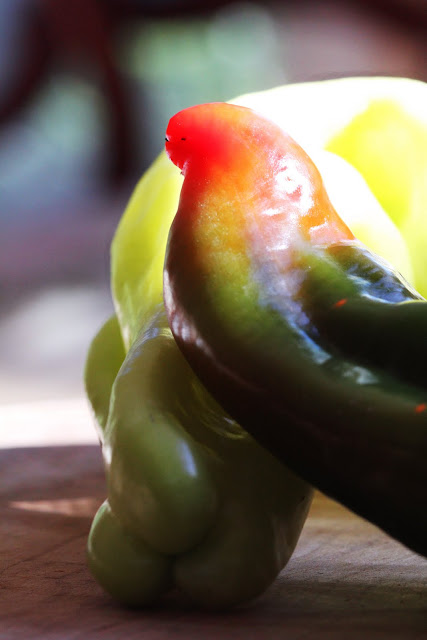Peppers, peppers..peppers.
I've been putting off the post about Peppers for quite some time. I haven't made up my mind about bell peppers. I know they have raving reviews from health experts, etc. - I'm just not in love...yet.
Every time I eat a bell pepper, it is usually all mushy and makes my stomach feel bloated in about 6.5 minutes. I don't know if it's just the fact that people tend to overcook them, or if they just don't suit my veggie palette.
Peppers -or if you feel so inclined to call them, Capsicums (you're welcome Simon Bentley), are very nutritious. The Capsicum "umbrella" of peppers includes many varieties, namely hot chili peppers and sweet bell peppers (red, yellow, green and purple). Bell peppers are members of the nightshade family, which includes potatoes, tomatoes and eggplant. Interestingly enough, green bell peppers are the same variety as red bell peppers, except that the green ones are less ripe & nutritious. They contain twice as much vitamin C and 11 times more beta-carotene.
All peppers are a rich source of vitamin C, beta-carotene and B vitamins. Many peppers also contain inflammation-reducing phytochemicals & flavonoids. Furthermore, medical studies have recently shown that capsaicin (a key ingredient in peppers) has many other potential health benefits, like preventing skin cancer and prostate cancer growth. Sounds like a sweet deal to me.
Many of you may be wondering why some peppers are hotter and/or sweeter than others. The spicy peppers have groups of phytochemicals called capsaicinoids, which creates the pain caused by heat in your mouth.
Capsaicin is the primary capsaicinoid and can be distributed in varying degrees throughout the vegetable. Bell peppers have virtually no capsaicin, while habanero varieties have quite a substantial amount. The larger the pepper, the more mild they tend to be because they contain fewer seeds and white membrane (spicy part) in proportion to their size.
Tips for preparing & eating Peppers:
1. A trick my mom just taught me while barbequing bell peppers is to remove the skins before eating them. This is the healthier option since you will not be consuming the blackened parts which may contain cancer-causing substances known as carcinogens. After grilling the peppers, place peppers in a paper bag and close tightly for 15 minutes. This allows them to steam, so that removing their skins will be quite easy. Try it!
2. Add chopped up jalapeno or serrano peppers to your favorite salsa. This will spice it up! A great salsa combination with these peppers is chopped tomatoes, onions, garlic, green peppers, grilled corn and tomatillos.
3. Add a dash of cayenne pepper to any dish. Cayenne pepper has shown to have many health benefits and keeps your metabolism buzzing.
4. Buy organically grown peppers, as their skin is very permeable and sensitive to pesticides. Bell peppers are a member of the "dirty dozen," which is something everyone needs to become more aware of. Please click here for more information.
A personal favorite:
Insalata Ottimista
I make this dish occasionally. It's simply, delicious and worth talking about. Check it out:
1 organic bell pepper
2 handfuls of organic arugula (or more if you love arugula, like me)
1 pinch of red chili flakes
2 pinches of sea salt
1/4 cup of shaved imported Parmigiano Reggiano
1/4 cup of shaved imported Parmigiano Reggiano
2 drizzles of garlic infused EVOO
1 drizzle of 25 year old aged Balsamic Vinegar from Il Fustino in Santa Barbara (best thing in the world).
Chop the bell pepper up in to strips and lay down as the bed of the salad. Drizzle a little EVOO and add the arugula on top. The salt, chili flakes and vinegar go directly on top of that. And the pièce de résistance, the cheese.



No comments:
Post a Comment